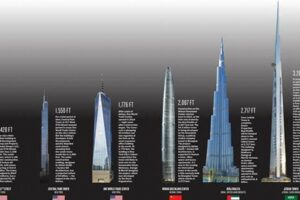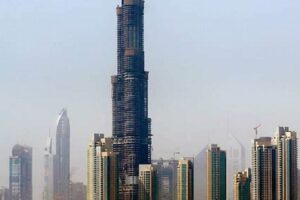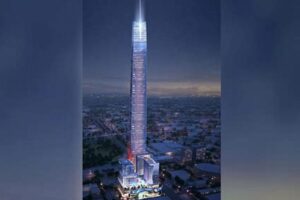The world’s tallest skyscrapers are architectural marvels that push the boundaries of engineering and design. These towering structures not only redefine skylines but also serve as symbols of economic prosperity and technological advancement.
The Burj Khalifa, standing at 828 meters tall, has held the title of the world’s tallest building since 2010. This iconic skyscraper in Dubai features 162 floors, housing luxury apartments, offices, and a hotel. Other notable supertall buildings include the Shanghai Tower (632 meters), Makkah Royal Clock Tower (601 meters), and Ping An Finance Center (599 meters).
The construction of the tallest skyscrapers involves complex engineering challenges, including structural stability, wind resistance, and efficient energy management. These buildings often incorporate cutting-edge technologies and sustainable design elements to minimize their environmental impact. Moreover, they serve as hubs for businesses, tourism, and cultural activities, contributing to the economic and social development of cities.
1. Height
Height is a defining characteristic of the tallest skyscrapers in the world for 2023. These architectural marvels soar above the clouds, reaching unprecedented heights that challenge the limits of engineering and design. The height of these skyscrapers is not merely a matter of aesthetics; it serves several important functions:
- Economic Impact: Taller buildings can accommodate more tenants, businesses, and visitors, leading to increased revenue and economic growth for the surrounding area.
- Landmark Status: The height of these skyscrapers makes them iconic landmarks, attracting tourists and enhancing the city’s global recognition.
- Engineering Innovation: Pushing the boundaries of height requires innovative engineering solutions to ensure structural stability and safety.
- Sustainability: Taller buildings can incorporate sustainable design features, such as wind turbines and rainwater harvesting systems, to minimize their environmental impact.
- Cultural Significance: The height of these skyscrapers can symbolize a nation’s economic power and technological advancement.
Examples of the world’s tallest skyscrapers in 2023 include the Burj Khalifa in Dubai (828 meters), the Shanghai Tower in China (632 meters), and the Makkah Royal Clock Tower in Saudi Arabia (601 meters). These giants of architecture not only redefine skylines but also represent the pinnacle of human ingenuity and engineering prowess.
In conclusion, height is a crucial aspect of the tallest skyscrapers in the world for 2023, driving economic growth, innovation, and cultural significance. It challenges the boundaries of engineering and design, while providing practical benefits and serving as symbols of national pride and technological advancement.
2. Design
Design plays a pivotal role in the conception and execution of the tallest skyscrapers in the world for 2023. It encompasses a wide range of considerations that go beyond aesthetics, including:
- Structural Integrity: The design of these skyscrapers must prioritize structural stability to withstand high winds, seismic activity, and other environmental forces.
- Energy Efficiency: Sustainable design principles are incorporated to minimize energy consumption and reduce the environmental impact of these massive structures.
- Functionality: The design must accommodate various functions, including office spaces, residential units, retail outlets, and public amenities, ensuring efficient and convenient use of the building.
- Aesthetics: The design of these skyscrapers often incorporates striking architectural elements that create unique and recognizable landmarks.
- Cultural Context: The design may reflect the cultural and historical context of the location, incorporating elements that resonate with the local community.
Examples of innovative design in the tallest skyscrapers of 2023 include the parametric facade of the Burj Khalifa, the spiraling form of the Shanghai Tower, and the traditional Chinese architectural influences in the design of the Ping An Finance Center.
In conclusion, design is a fundamental aspect of the tallest skyscrapers in the world for 2023. It encompasses structural integrity, energy efficiency, functionality, aesthetics, and cultural context, resulting in iconic architectural marvels that push the boundaries of engineering and design.
3. Engineering
Engineering is the cornerstone of the tallest skyscrapers in the world for 2023. It encompasses a wide range of disciplines, including structural, civil, and environmental engineering, to create these architectural marvels that defy gravity and redefine skylines.
Structural engineering is paramount in ensuring the stability and integrity of these towering structures. Engineers must meticulously design every aspect of the building, from the foundation to the spire, to withstand extreme forces such as high winds, earthquakes, and even potential terrorist attacks. Advanced materials like reinforced concrete, steel alloys, and composite materials are employed to achieve both strength and flexibility.
Civil engineering plays a crucial role in the planning, construction, and maintenance of the tallest skyscrapers. Engineers must carefully consider factors such as site selection, soil conditions, and environmental impact. They design efficient and sustainable infrastructure, including transportation systems, water supply, and energy distribution, to support the skyscraper’s operation and the surrounding urban environment.
Environmental engineering principles are incorporated to minimize the ecological footprint of these massive structures. Engineers implement green building technologies, such as rainwater harvesting systems, solar panels, and energy-efficient lighting, to reduce energy consumption and carbon emissions. Sustainable materials and construction methods are employed to lessen the environmental impact throughout the skyscraper’s life cycle.
The engineering behind the tallest skyscrapers in the world for 2023 represents the pinnacle of human ingenuity and innovation. It pushes the boundaries of what is possible, creating structures that are not only symbols of architectural prowess but also testaments to the power of engineering to shape our built environment.
4. Sustainability
Sustainability is an integral component of the tallest skyscrapers in the world for 2023. As these architectural marvels soar higher and become more complex, the need to minimize their environmental impact becomes increasingly important.
One of the key challenges in sustainable skyscraper design is energy consumption. These massive structures require vast amounts of energy for lighting, heating, cooling, and other operations. To address this, architects and engineers are incorporating energy-efficient technologies and renewable energy sources into their designs. For example, the Burj Khalifa in Dubai utilizes a double-skin facade that reduces heat gain and energy consumption. The Shanghai Tower in China features wind turbines that generate renewable energy for the building.
Another aspect of sustainability in skyscrapers is water conservation. Rainwater harvesting systems are becoming increasingly common, collecting and storing rainwater for non-potable uses such as irrigation and toilet flushing. The Ping An Finance Center in Shenzhen, China, has a rainwater collection system that can store up to 10 million liters of water.
Sustainable skyscrapers also prioritize the use of eco-friendly materials and construction methods. Recycled and renewable materials are being used to reduce the environmental impact of construction. The One World Trade Center in New York City incorporates recycled steel and glass in its design.
The practical significance of sustainable skyscrapers is undeniable. They reduce operating costs, enhance occupant well-being, and contribute to the overall sustainability of cities. By embracing sustainable practices, the tallest skyscrapers in the world for 2023 are not only architectural marvels but also beacons of environmental responsibility.
In conclusion, sustainability is a cornerstone of modern skyscraper design. By incorporating energy-efficient technologies, renewable energy sources, water conservation systems, and eco-friendly materials, architects and engineers are creating skyscrapers that are not only towering symbols of human ingenuity but also responsible stewards of the environment.
5. Function
The tallest skyscrapers in the world for 2023 are not merely architectural feats; they are also multifunctional structures that serve a variety of purposes, shaping the urban landscape and meeting the diverse needs of modern society.
One of the primary functions of these skyscrapers is to provide commercial office space. These towering structures house businesses, corporations, and financial institutions, creating hubs for economic activity and innovation. The Burj Khalifa in Dubai, for example, is home to a mix of international companies and luxury offices.
Residential living is another important function of the tallest skyscrapers. Luxury apartments and penthouses offer breathtaking views and exclusive amenities, catering to a discerning clientele. The Shanghai Tower in China features high-end residential units, along with retail and leisure facilities.
In addition to commercial and residential uses, the tallest skyscrapers often incorporate retail, hospitality, and entertainment venues. Shopping malls, restaurants, and observation decks attract visitors and create vibrant urban destinations. The One World Trade Center in New York City houses a retail complex and a museum, while the Ping An Finance Center in Shenzhen boasts a luxury hotel and a rooftop observation deck.
The practical significance of understanding the function of the tallest skyscrapers lies in its impact on urban planning and development. By understanding the diverse uses of these structures, architects, engineers, and city planners can create more livable, sustainable, and economically vibrant cities.
In conclusion, the function of the tallest skyscrapers in the world for 2023 extends beyond their architectural grandeur. They serve as multifunctional hubs for commerce, living, leisure, and tourism, contributing to the economic and social vitality of cities.
6. Location
The location of the tallest skyscrapers in the world for 2023 is a crucial factor that shapes their design, function, and impact. These architectural marvels are often constructed in major metropolitan centers, where they become iconic landmarks and symbols of economic power and technological advancement.
One primary reason for the concentration of tall skyscrapers in metropolitan areas is the availability of land and infrastructure. Densely populated cities offer limited space for horizontal expansion, making vertical development a practical solution. Moreover, these urban centers provide access to transportation hubs, financial services, and a skilled workforce, which are essential for the success of tall skyscrapers.
For example, the Burj Khalifa in Dubai is located in the heart of the city’s business district, providing convenient access to major corporations and financial institutions. The Shanghai Tower in China is situated in the Pudong district, a hub for finance, trade, and shipping. These locations enhance the functionality and economic viability of these skyscrapers.
Furthermore, the location of tall skyscrapers can influence their design and engineering. Factors such as wind patterns, seismic activity, and soil conditions must be carefully considered during the construction process. For instance, the Taipei 101 in Taiwan incorporates a unique wind damper system to withstand the region’s strong winds.
Understanding the connection between location and the tallest skyscrapers in the world for 2023 is essential for urban planning and development. It enables architects, engineers, and city planners to create sustainable and livable urban environments. By carefully selecting locations and considering the surrounding infrastructure and environment, these iconic structures can positively contribute to the economic growth and overall well-being of cities.
7. Symbolism
The tallest skyscrapers in the world for 2023 transcend their architectural grandeur and functional significance; they also serve as powerful symbols that reflect the aspirations, values, and economic prowess of the cities and nations they inhabit.
These towering structures often embody a city’s ambition and desire for recognition. The Burj Khalifa in Dubai, standing at 828 meters, symbolizes the city’s rapid economic growth and its a global metropolis. Similarly, the Shanghai Tower in China represents the country’s growing economic and technological might.
Tall skyscrapers can also symbolize national pride and identity. The Petronas Towers in Kuala Lumpur, Malaysia, are iconic symbols of the country’s independence and economic development. The One World Trade Center in New York City stands as a symbol of resilience and strength following the 9/11 attacks.
Understanding the symbolic significance of the tallest skyscrapers in the world for 2023 is crucial for urban planning and development. It enables architects, engineers, and city planners to create structures that not only meet functional needs but also resonate with the cultural and historical context of their surroundings.
Moreover, this understanding can guide decision-making processes related to the preservation and conservation of these iconic landmarks. By recognizing the symbolic value of tall skyscrapers, cities can ensure their protection and continued relevance for future generations.
Frequently Asked Questions about the Tallest Skyscrapers in the World 2023
This section addresses commonly asked questions and misconceptions surrounding the tallest skyscrapers in the world for 2023.
Question 1: What is the tallest skyscraper in the world for 2023?
Answer: As of 2023, the Burj Khalifa in Dubai, United Arab Emirates, remains the tallest skyscraper in the world, standing at an impressive height of 828 meters (2,717 feet).
Question 2: How many skyscrapers are over 500 meters tall?
Answer: Currently, there are 13 skyscrapers over 500 meters tall worldwide, with the majority located in China and the United Arab Emirates.
Question 3: Are these skyscrapers safe during earthquakes?
Answer: Yes, modern skyscrapers are designed to withstand earthquakes and other natural disasters. They employ advanced engineering techniques, such as base isolation and tuned mass dampers, to minimize structural damage and ensure occupant safety.
Question 4: How do these skyscrapers reduce their environmental impact?
Answer: Many tall skyscrapers incorporate sustainable design features to reduce their environmental footprint. These features include energy-efficient lighting, rainwater harvesting systems, and the use of recycled materials.
Question 5: What are the main functions of these skyscrapers?
Answer: The tallest skyscrapers primarily serve commercial purposes, housing offices, retail spaces, and luxury apartments. They may also include amenities such as hotels, restaurants, and observation decks.
Question 6: How do these skyscrapers affect urban development?
Answer: Skyscrapers play a significant role in urban development by concentrating economic activity and population density in specific areas. They can contribute to increased land value, job creation, and tourism.
These frequently asked questions provide a deeper understanding of the tallest skyscrapers in the world for 2023, their design, functionality, and impact on the built environment.
Transition to the next article section: “Conclusion”
Tips Related to the Tallest Skyscrapers in the World 2023
The construction and management of the tallest skyscrapers in the world for 2023 require meticulous planning and innovative approaches. Here are some key tips based on the latest industry practices and expert insights:
Tip 1: Prioritize Structural Integrity and Safety
Ensuring the structural integrity of skyscrapers is paramount. Utilize advanced engineering techniques, such as reinforced concrete and steel frameworks, and conduct thorough seismic and wind resistance analyses to withstand extreme forces.
Tip 2: Embrace Sustainable Design Principles
Incorporate eco-friendly materials, energy-efficient systems, and water conservation measures to minimize environmental impact. Consider renewable energy sources, rainwater harvesting, and green facades to reduce carbon footprint.
Tip 3: Optimize Space Utilization and Functionality
Maximize space efficiency through innovative floor plans and versatile designs. Utilize mixed-use concepts to accommodate diverse functions, such as offices, residential units, and retail spaces, within a single structure.
Tip 4: Implement Advanced Construction Technologies
Employ prefabrication, modular construction, and Building Information Modeling (BIM) to enhance construction efficiency, reduce waste, and improve safety. Utilize cutting-edge technologies to streamline processes and optimize building performance.
Tip 5: Prioritize Tenant Comfort and Well-being
Design skyscrapers with ample natural light, proper ventilation, and comfortable indoor environments. Incorporate amenities such as fitness centers, green spaces, and communal areas to enhance tenant well-being and productivity.
Key Takeaways
By adhering to these tips, architects, engineers, and developers can create the tallest skyscrapers in the world for 2023 that are not only architectural marvels but also safe, sustainable, and functional. These structures will continue to redefine skylines, drive economic growth, and serve as symbols of human ingenuity and innovation.
Transition to the article’s conclusion
In conclusion, the tallest skyscrapers in the world for 2023 represent the pinnacle of architectural achievement and engineering prowess. By incorporating these tips into the planning and construction process, we can create structures that push the boundaries of design, sustainability, and functionality, leaving a lasting legacy on the global built environment.
Conclusion
The tallest skyscrapers in the world for 2023 stand as testaments to human ingenuity, engineering prowess, and the relentless pursuit of architectural excellence. These towering giants have redefined skylines, driven economic growth, and become symbols of national pride and technological advancement.
As we look to the future, the construction of skyscrapers will continue to push the boundaries of design, sustainability, and functionality. By embracing innovative technologies, sustainable practices, and a commitment to human well-being, we can create skyscrapers that not only reach new heights but also contribute positively to the built environment and the communities they serve.







